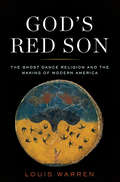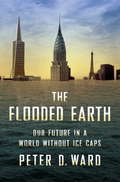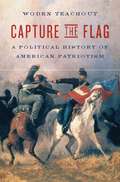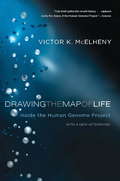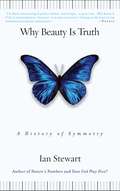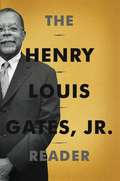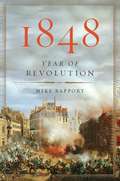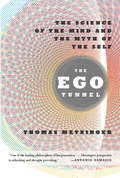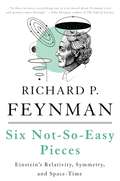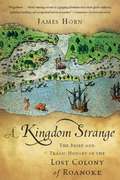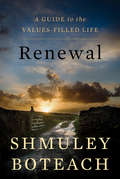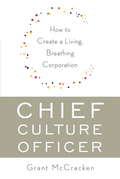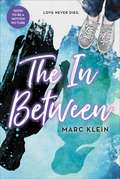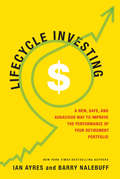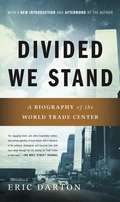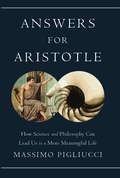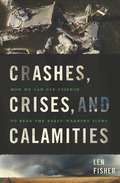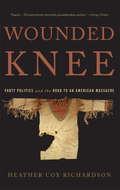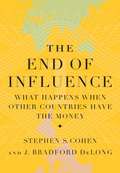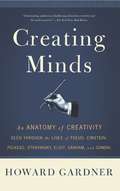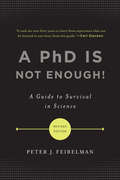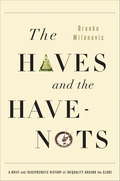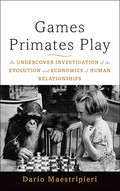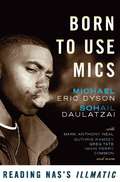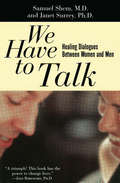- Table View
- List View
God's Red Son: The Ghost Dance Religion and the Making of Modern America
by Louis S. WarrenIn 1890, on Indian reservations across the West, followers of a new religion danced in circles until they collapsed into trances. In an attempt to suppress this new faith, the US Army killed over two hundred Lakota Sioux at Wounded Knee Creek. Louis Warren's God's Red Son offers a startling new view of the religion known as the Ghost Dance, from its origins in the visions of a Northern Paiute named Wovoka to the tragedy in South Dakota. To this day, the Ghost Dance remains widely mischaracterized as a primitive and failed effort by Indian militants to resist American conquest and return to traditional ways. In fact, followers of the Ghost Dance sought to thrive in modern America by working for wages, farming the land, and educating their children, tenets that helped the religion endure for decades after Wounded Knee. God's Red Son powerfully reveals how Ghost Dance teachings helped Indians retain their identity and reshape the modern world.
Flooded Earth: Our Future In a World Without Ice Caps
by Peter D. WardSea level rise will happen no matter what we do. Even if we stopped all carbon dioxide emissions today, the seas would rise one meter by 2050 and three meters by 2100. This--not drought, species extinction, or excessive heat waves--will be the most catastrophic effect of global warming. And it won’t simply redraw our coastlines--agriculture, electrical and fiber optic systems, and shipping will be changed forever. As icebound regions melt, new sources of oil, gas, minerals, and arable land will be revealed, as will fierce geopolitical battles over who owns the rights to them. In The Flooded Earth, species extinction expert Peter Ward describes in intricate detail what our world will look like in 2050, 2100, 2300, and beyond--a blueprint for a foreseeable future. Ward also explains what politicians and policymakers around the world should be doing now to head off the worst consequences of an inevitable transformation.
Capture the Flag: A Political History of American Patriotism
by Woden TeachoutAmericans honor the flag with a fervor seen in few other countries: The Stars and Stripes decorate American homes and businesses; wave over sports events and funerals; and embellish everything from politicians' lapels to the surface of the moon.But what does the flag mean? In Capture the Flag, historian Woden Teachout reveals that it has held vastly different meanings over time. It has been claimed by both the right and left; by racists and revolutionaries; by immigrants and nativists. In tracing the political history of the flag from its origins in the American Revolution through the present day, Teachout demonstrates that the shifting symbolism of the flag reveals a broader shift in the definition of American patriotism.A story of a nation in search of itself, Capture the Flag offers a probing account of the flag that has become America's icon.
Drawing the Map of Life: Inside the Human Genome Project (A Merloyd Lawrence Book)
by Victor K. McelhenyDrawing the Map of Life is the dramatic story of the Human Genome Project from its origins, through the race to order the 3 billion subunits of DNA, to the surprises emerging as scientists seek to exploit the molecule of heredity. It's the first account to deal in depth with the intellectual roots of the project, the motivations that drove it, and the hype that often masked genuine triumphs.Distinguished science journalist Victor McElheny offers vivid, insightful profiles of key people, such as David Botstein, Eric Lander, Francis Collins, James Watson, Michael Hunkapiller, and Craig Venter. McElheny also shows that the Human Genome Project is a striking example of how new techniques (such as restriction enzymes and sequencing methods) often arrive first, shaping the questions scientists then ask.Drawing on years of original interviews and reporting in the inner circles of biological science, Drawing the Map of Life is the definitive, up-to-date story of today's greatest scientific quest. No one who wishes to understand genome mapping and how it is transforming our lives can afford to miss this book.
Why Beauty is Truth: The History of Symmetry
by Ian StewartAt the heart of relativity theory, quantum mechanics, string theory, and much of modern cosmology lies one concept: symmetry. <P><P> In Why Beauty Is Truth, world-famous mathematician Ian Stewart narrates the history of the emergence of this remarkable area of study. Stewart introduces us to such characters as the Renaissance Italian genius, rogue, scholar, and gambler Girolamo Cardano, who stole the modern method of solving cubic equations and published it in the first important book on algebra, and the young revolutionary Evariste Galois, who refashioned the whole of mathematics and founded the field of group theory only to die in a pointless duel over a woman before his work was published. Stewart also explores the strange numerology of real mathematics, in which particular numbers have unique and unpredictable properties related to symmetry. He shows how Wilhelm Killing discovered "Lie groups" with 14, 52, 78, 133, and 248 dimensions-groups whose very existence is a profound puzzle. Finally, Stewart describes the world beyond superstrings: the "octonionic" symmetries that may explain the very existence of the universe.
The Henry Louis Gates, Jr. Reader
by Henry Louis Gates Jr. Abby WolfA primer from one of AmericaOCOs most esteemed and popular intellectuals"
1848: Year of Revolution
by Mike RapportIn 1848, a violent storm of revolutions ripped through Europe. The torrent all but swept away the conservative order that had kept peace on the continent since Napoleon's defeat at Waterloo in 1815--but which in many countries had also suppressed dreams of national freedom. Political events so dramatic had not been seen in Europe since the French Revolution, and they would not be witnessed again until 1989, with the revolutions in Eastern and Central Europe. In1848, historian Mike Rapport examines the roots of the ferment and then, with breathtaking pace, chronicles the explosive spread of violence across Europe. A vivid narrative of a complex chain of interconnected revolutions,1848tells the exhilarating story of Europe's violent "Spring of Nations" and traces its reverberations to the present day.
The Ego Tunnel: The Science of the Mind and the Myth of the Self
by Thomas MetzingerWe’re used to thinking about the self as an independent entity, something that we either have or are. InThe Ego Tunnel, philosopher Thomas Metzinger claims otherwise: No such thing as aselfexists. The conscious self is the content of a model created by our brain-an internal image, but one we cannot experienceasan image. Everything we experience is "a virtual self in a virtual reality. ” But if the self is not "real,” why and how did it evolve? How does the brain construct it? Do we still have souls, free will, personal autonomy, or moral accountability? In a time when the science of cognition is becoming as controversial as evolution,The Ego Tunnelprovides a stunningly original take on the mystery of the mind.
Six Not-So-Easy Pieces: Einstein's Relativity, Symmetry, and Space-Time
by Matthew Sands Robert B. Leighton Richard P. FeynmanSix lectures, all regarding the most revolutionary discovery in twentieth-century physics: Einstein's Theory of Relativity. No one--not even Einstein himself--explained these difficult, anti-intuitive concepts more clearly, or with more verve and gusto, than Feynman.
A Kingdom Strange: The Brief and Tragic History of the Lost Colony of Roanoke
by James HornIn 1587, John White and 117 men, women, and children landed off the coast of North Carolina on Roanoke Island, hoping to carve a colony from fearsome wilderness. A mere month later, facing quickly diminishing supplies and a fierce native population, White sailed back to England in desperation. He persuaded the wealthy Sir Walter Raleigh, the expedition's sponsor, to rescue the imperiled colonists, but by the time White returned with aid the colonists of Roanoke were nowhere to be found. He never saw his friends or family again.In this gripping account based on new archival material, colonial historian James Horn tells for the first time the complete story of what happened to the Roanoke colonists and their descendants. A compellingly original examination of one of the great unsolved mysteries of American history, A Kingdom Strange will be essential reading for anyone interested in our national origins.
Renewal: A Guide to the Values-Filled Life
by Rabbi Shmuley BoteachOur culture is showing the cracks of a growing fracture. Soaring divorce rates; a crippled economy that rewards the few and punishes the many; religious-fueled hatred; record rates of depression--the headlines paint a grim picture. We inhabit a society that desperately needs fixing. But as Rabbi Shmuley Boteach reveals in his new book, Renewal, our society can made whole again when we as individuals make the choice to live a life based on values. For too long, conversations about values have been derailed by political movements trying to score points over hot-button issues like gay marriage or abortion. Boteach, one of our wisest and most respected counselors and spiritual experts, reaches deep into our history and into our shared religious legacy to revive the key universal values of Judaism for our struggling world. He presents these age-old ideas as guideposts for the challenges of modern times. These values, whose roots are in the Bible and thousands of years of Jewish spiritual living, can be applied to anyone in the modern world--from Christians and Muslims to atheists and agnostics--who want to renew their existence and recommit themselves to the most precious things in life. Renewal shows everyone how to use the timeless values of the Hebrew Bible and Judaism to live a more fulfilling, modern life. Destiny Unlike the Greeks, who believed that life was scripted from birth, the Jews believe in destiny. In short, they reject the idea of tragic fates and instead champion the individuals' capacity to create their own destiny through individual choice. Redemption Christians and Muslims emphasize salvation, or the need for man to become spiritual--to refine his character and earn a place in heaven. But Jews believe in world redemption, the capacity for the individuals to make heaven here on earth for,the betterment of the community. Action What you do is more important than what you believe. Good deeds always supersede good dogma. Enlightenment Jews are an infinitely curious people and believe that the great bane of existence--boredom--can only be cured by knowledge. Marriage Marriage refers not just to the institution, but rather the softening of the masculine by exposure to the feminine. A culture that does not know how to respect women is bound to collapse. Struggle It is wrestling with our nature, rather than attaining perfection, that constitutes true righteousness. Everyone is somehow flawed, but righteousness is found in the struggle to do right amid a predilection to act selfishly. Sacred Time Whereas other religions sanctify space, Jewish values privilege special moments. The Sabbath day, the holiest day of the week, provides a time for connecting with family and friends.
Chief Culture Officer: How to Create a Living, Breathing Corporation
by Grant MccrackenLevi-Strauss, the jeans and apparel maker, missed out on the hip-hop trend. They didn't realize that those kids in baggy jeans represented a whole new--and lucrative--market opportunity, one they could have seen coming if they had but been paying attention to the shape of American culture. Levi Strauss isn't alone. Too many corporations outsource their understanding of culture to trend hunters, cool watchers, marketing experts, consulting firms, and, sometimes, teenage interns. The cost to Levi-Strauss was a billion dollars. The cost to the rest of corporate America is immeasurable. The lesson? The American corporation needs a new professional. It needs a Chief Culture Officer. Grant McCracken, an anthropologist who now trains some of the world's biggest companies and consulting firms, argues that the CCO would keep a finger on the pulse of contemporary cultural trends--from sneakers to slow food to preppies--while developing a systematic understanding of the deep waves of culture in America and the world. The CCO's professionalism would allow the corporation to see coming changes, even when they only exist as the weakest of signals. Delightfully authoritative, trenchantly on point, bursting with insight and character, Chief Culture Officer is sure to expand your horizons--and your business.
The In Between
by Marc KleinThis heartbreaking story—perfect for fans of If I Stay and Five Feet Apart—follows a girl swept up in the magic of her first love, until it all comes to a tragic end that might lead her into the afterlife itself. Soon to be a motion picture.After bouncing around in foster homes for most of her childhood, seventeen-year-old Tessa Jacobs doesn&’t believe she deserves love—not from her adoptive parents, and certainly not from anyone at school.But everything changes when she has a chance encounter with Skylar, a senior from a neighboring town who&’s a true romantic. Their budding relationship quickly leads to the kind of passion you only see in the movies. As her heart begins to open, Tessa starts to believe she might be deserving of love after all.When tragedy strikes, Tessa wakes up alone in a hospital room with no memory of how she got there. And then she learns the horrifying news: Skylar is dead. As Tessa searches for answers, Skylar&’s spirit reaches out to her from the other side. Desperate to see him one last time, Tessa must race against the clock to uncover the shocking truth of their relationship—a truth that might just lead to the afterlife itself.
The Lifecycle Investor: A New, Safe, and Audacious Way to Improve the Performance of Your Retirement Portfolio
by Ian Ayres Barry NalebuffDiversification provides a well-known way of getting something close to a free lunch: by spreading money across different kinds of investments, investors can earn the same return with lower risk (or a much higher return for the same amount of risk). This strategy, introduced nearly fifty years ago, led to such strategies as index funds. What if we were all missing out on another free lunch that's right under our noses? In Lifecycle Investing, Barry Nalebuff and Ian Ayres--two of the most innovative thinkers in business, law, and economics--have developed tools that will allow nearly any investor to diversify their portfolios over time. By using leveraging when young--a controversial idea that sparked hate mail when the authors first floated it in the pages of Forbes--investors of all stripes, from those just starting to plan to those getting ready to retire, can substantially reduce overall risk while improving their returns. In Lifecycle Investing, readers will learn How to figure out the level of exposure and leverage that's right for you How the Lifecycle Investing strategy would have performed in the historical market Why it will work even if everyone does it When not to adopt the Lifecycle Investing strategy Clearly written and backed by rigorous research, Lifecycle Investing presents a simple but radical idea that will shake up how we think about retirement investing even as it provides a healthier nest egg in a nicely feathered nest.
Divided We Stand: A Biography Of New York's World Trade Center
by Eric DartonWhen the World Trade Towers in New York City were erected at the Hudson’s edge, they led the way to a real estate boom that was truly astonishing. Divided We Standreveals the coming together and eruption of four volatile elements: super-tall buildings, financial speculation, globalization, and terrorism. The Trade Center serves as a potent symbol of the disastrous consequences of undemocratic planning and development. This book is a history of that skyscraping ambition and the impact it had on New York and international life. It is a portrait of a building complex that lives at the convergence point of social and economic realities central not only to New York City but to all industrial cities and suburbs. A meticulously researched historical account based on primary documents,Divided We Standis a contemporary indictment of the prevailing urban order in the spirit of Jane Jacobs’s mid-century classicThe Death and Life of Great American Cities.
Answers for Aristotle: How Science and Philosophy Can Lead Us to A More Meaningful Life
by Massimo PigliucciHow should we live? According to philosopher and biologist Massimo Pigliucci, the greatest guidance to this essential question lies in combining the wisdom of 24 centuries of philosophy with the latest research from 21st century science. In Answers for Aristotle, Pigliucci argues that the combination of science and philosophy first pioneered by Aristotle offers us the best possible tool for understanding the world and ourselves. As Aristotle knew, each mode of thought has the power to clarify the other: science provides facts, and philosophy helps us reflect on the values with which to assess them. But over the centuries, the two have become uncoupled, leaving us with questions—about morality, love, friendship, justice, and politics—that neither field could fully answer on its own. Pigliucci argues that only by rejoining each other can modern science and philosophy reach their full potential, while we harness them to help us reach ours. Pigliucci discusses such essential issues as how to tell right from wrong, the nature of love and friendship, and whether we can really ever know ourselves—all in service of helping us find our path to the best possible life. Combining the two most powerful intellectual traditions in history, Answers for Aristotle is a remarkable guide to discovering what really matters and why.
Crashes, Crises, and Calamities: How We Can Use Science to Read the Early-Warning Signs
by Len FisherWhy do certain civilizations, societies, and ecosystems collapse? How does the domino effect relate to the credit crunch? When can mathematics help explain marriage? And how on earth do toads predict earthquakes? The future is uncertain. But science can help foretell what lies ahead. Drawing on ecology and biology, math and physics, Crashes, Crises, and Calamities offers four fundamental tools that scientists and engineers use to forecast the likelihood of sudden change: stability, catastrophe, complexity, and game theories. In accessible prose, Len Fisher demonstrates how we can foresee and manage events that might otherwise catch us by surprise. At the cutting edge of science, Fisher helps us find ways to act before a full-fledged catastrophe is upon us. Crashes, Crises, and Calamities is a witty and informative exploration of the chaos, complexity, and patterns of our daily lives.
Wounded Knee: Party Politics and the Road to an American Massacre (Great Plains Photography Ser.)
by Heather Cox RichardsonOn December 29, 1890, American troops opened fire with howitzers on hundreds of unarmed Lakota Sioux men, women, and children near Wounded Knee Creek in South Dakota, killing nearly 300 Sioux. As acclaimed historian Heather Cox Richardson shows in Wounded Knee, the massacre grew out of a set of political forces all too familiar to us today: fierce partisanship, heated political rhetoric, and an irresponsible, profit-driven media. Richardson tells a dramatically new story about the Wounded Knee massacre, revealing that its origins lay not in the West but in the corridors of political power back East. Politicians in Washington, Democrat and Republican alike, sought to set the stage for mass murder by exploiting an age-old political tool-fear. Assiduously researched and beautifully written, Wounded Knee will be the definitive account of an epochal American tragedy.
The End of Influence: What Happens When Other Countries Have the Money
by Stephen Cohen J. Brandford DelongNow that the US is not the worldOCOs biggest banker, its future as a superpower is looking shaky.
Creating Minds: An Anatomy of Creativity as Seen Through the Lives of Freud, Einstein, Picasso, Stravinsky, Eliot, G
by Howard GardnerThe man who revolutionized our understanding of intelligence now gives us a pathbreaking view of creativity, along with riveting portraits of seven figures who each reinvented an area of human endeavor. Understanding their diverse achievements not only sheds light on the nature of creativity but also elucidates the “modern era”-the times that formed them and that they in turn helped to define.
A PhD Is Not Enough!: A Guide to Survival in Science
by Peter J. FeibelmanDespite your graduate education, brainpower, and technical prowess, your career in scientific research is far from assured. Permanent positions are scarce, science survival is rarely part of formal graduate training, and a good mentor is hard to find. InA Ph. D. Is Not Enough!, physicist Peter J. Feibelman lays out a rational path to a fulfilling long-term research career. He offers sound advice on selecting a thesis or postdoctoral adviser; choosing among research jobs in academia, government laboratories, and industry; preparing for an employment interview; and defining a research program. The guidance offered inA Ph. D. Is Not Enough!will help you make your oral presentations more effective, your journal articles more compelling, and your grant proposals more successful. A classic guide for recent and soon-to-be graduates,A Ph. D. Is Not Enough!remains required reading for anyone on the threshold of a career in science. This new edition includes two new chapters and is revised and updated throughout to reflect how the revolution in electronic communication has transformed the field.
The Haves and the Have-Nots: A Brief and Idiosyncratic History of Global Inequality
by Branko MilanovicWho is the richest person in the world, ever? Does where you were born affect how much money you'll earn over a lifetime? How would we know? Why--beyond the idle curiosity--do these questions even matter? In The Haves and the Have-Nots, Branko Milanovic, one of the world's leading experts on wealth, poverty, and the gap that separates them, explains these and other mysteries of how wealth is unevenly spread throughout our world, now and through time. Milanovic uses history, literature and stories straight out of today's newspapers, to discuss one of the major divisions in our social lives: between the haves and the have-nots. He reveals just how rich Elizabeth Bennet's suitor Mr. Darcy really was; how much Anna Karenina gained by falling in love; how wealthy ancient Romans compare to today's super-rich; where in Kenyan income distribution was Obama's grandfather; how we should think about Marxism in a modern world; and how location where one is born determines his wealth. He goes beyond mere entertainment to explain why inequality matters, how it damages our economics prospects, and how it can threaten the foundations of the social order that we take for granted. Bold, engaging, and illuminating, The Haves and the Have-Nots teaches us not only how to think about inequality, but why we should.
Games Primates Play: An Undercover Investigation of the Evolution and Economics of Human Relationships
by Dario MaestripieriMost humans don’t realize that when they exchange emails with someone, anyone, they are actually exhibiting certain unspoken rules about dominance and hierarchy. The same rules regulate the exchange of grooming behavior in rhesus macaques or chimpanzees. Interestingly, some of the major aspects of human nature have profound commonalities with our ape ancestors: the violence of war, the intensity of love, the need to live together. While we often assume that our behavior in everyday situations reflects our unique personalities, the choices we freely make, or the influences of our environment, we rarely consider that others behave in these situations in almost the exact the same way as we do. In Games Primates Play, primatologist Dario Maestripieri examines the curious unspoken customs that govern our behavior. These patterns and customs appear to be motivated by free will, yet they are so similar from person to person, and across species, that they reveal much more than our selected choices. Games Primates Play uncovers our evolutionary legacy: the subtle codes that govern our behavior are the result of millions of years of evolution, predating the emergence of modern humans. To understand the rules that govern primate games and our social interactions, Maestripieri arms readers with knowledge of the scientific principles that ethologists, psychologists, economists, and other behavioral scientists have discovered in their quest to unravel the complexities of behavior. As he realizes, everything from how we write emails to how we make love is determined by the legacy of our primate roots and the conditions that existed so long ago. An idiosyncratic and witty approach to our deep and complex origins, Games Primates Play reveals the ways in which our primate nature drives so much of our lives.
Born to Use Mics: Reading Nas's Illmatic
by Michael Eric Dyson Sohail DaulatzaiAt the age of nineteen, Nasir "Nas” Jones began recording tracks for his debut album--and changed the music world forever. Released in 1994, Illmatic was hailed as an instant masterpiece and has proven one of the most influential albums in hip-hop history. With its close attention to beats and lyricism, and riveting first-person explorations of the isolation and desolation of urban poverty, Illmatic was pivotal in the evolution of the genre. In Born to Use Mics, Michael Eric Dyson and Sohail Daulatzai have brought together renowned writers and critics including Mark Anthony Neal, Marc Lamont Hill, Eddie S. Glaude, Jr. , and many others to confront Illmatic song by song, with each scholar assessing an individual track from the album. The result is a brilliant engagement with and commentary upon one of the most incisive sets of songs ever laid down on wax.
We Have to Talk: Healing Dialogues Between Women And Men
by Samuel Shem Janet SurreySamuel Shem and Janet Surrey, a remarkable husband-and-wife team, challenge bestselling books that say men and women must resign themselves to inherent differences between them. Drawing on their extensive clinical experience as psychiatrist and psychologist, Shem and Surrey outline a program of healing dialogues to help any couple move beyond superficial harmony to genuine connection.
